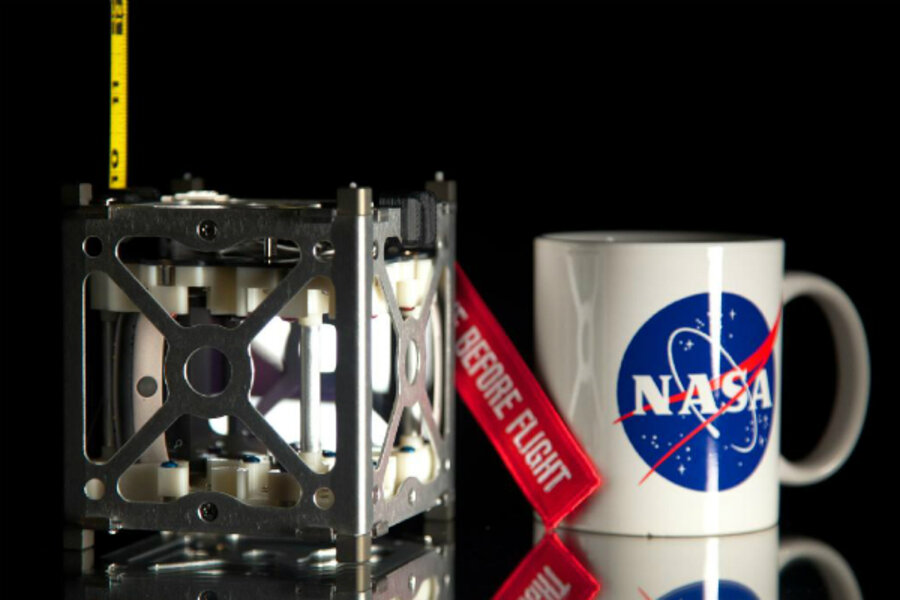Tiny satellites + cellphones = cheaper 'eyes in the sky' for NASA
Loading...
That's no smart phone in your pocket or purse; that's the heart and soul of a satellite.
Three satellites, to be exact, released into orbit on Sunday with the launch of Orbital Sciences Corp.'s new Antares rocket, the latest addition to NASA's stable of space-station resupply vehicles.
The tiny satellites, each occupying a cube four inches on a side, represent an experiment in using cheap but powerful off-the-shelf technology to run a new generation of small, affordable science satellites.
Two of these orbiters, which NASA has dubbed Phonesat 1.0, use the electronics and sensors packaged in a Google Nexus One smart phone to serve as on-board computers. Accelerometers that normally tell the phones which way you've oriented the screen now gather information on the satellites' orientation in space. And the cameras? Yep, snapshots of Earth from 156 miles up.
The third satellite, a prototype for Phonesat 2.0, uses a more powerful Nexus S, which also has a built-in gyroscope. Ultimately, engineers plan to use that extra capability to control solar panels and to control the spacecraft's orientation, instead of just recording it.
The notion of using a smart phone's innards to run a satellite grew out of informal hallway chatter, recalls James Cockrell, project manager for Phonesat at NASA's Ames Research Center at Moffett Field, Calif.
The benchmark people often use as a point of comparison for the power of their favorite laptop or smart phone is the primitive computing power used in the Apollo program, which landed humans on the moon and brought them back safely in the late 1960s and early '70s.
Indeed, Mr. Cockrell describes a trip to the Internet that netted him the electronic-circuit diagram for the navigation and control computer used in Apollo's Lunar Excursion Module.
"Oh my goodness, you could build it in your basement" with a circuit board and a few transistors, he says.
A couple of years ago, he says, an engineer at NASA-Ames was drawing a similar comparison between his smart phone and today's satellites during an informal hallway chat. The engineer noted that a smart phone's processor is 10 to 15 times more powerful than the processors used in a conventional satellite's computer. A smart phone has much more memory. And it boasts a GPS receiver, gyroscopes, and accelerometers – the sensors needed for navigation and to control a satellite's orientation.
"He said: 'I don't know why we couldn't make a satellite our of a smart phone,' " Cockrell recalls. Although it took a bit of additional salesmanship to convince folks higher up the organizational food chain, the Phonesat project was born.
The satellites cost about $3,500 each. The initial goals were modest: Survive the launch and beep at Earth.
So far, the satellites have successfully relayed their health – operating temperatures, battery status, and other key indicators – via small external transmitters.
"We call this our Sputnik moment," Cockrell says, referring to the simple "I'm alive" beeps that the world's first artificial satellite sent back to Earth in 1957.
As of Monday night, the two Phonesat 1 orbiters started taking pictures. Each satellite selected one image to beam back to Earth.
Before the beaming could begin, the image had to be cut into pieces. And yes, there's now an app for that.
And where NASA's flagship missions to the far reaches of the solar system use the agency's global Deep Space Network for communications, Phonesats are using what you could call NASA's cheap-and-not-so-deep space network – ham-radio operators worldwide.
So far, some 100 hams have registered at www.phonesat.org, a site the program has set up to receive the packets. As of Tuesday evening, Cockrell estimated that the website had collected more than 300 packets, which computers on Earth must sort through to eliminate duplicates. Ultimately the mosaic will be assembled and displayed online.
The three Phonesats are expected to reenter the atmosphere and vaporize at the end of their 10- to 14-day romp on orbit.
The project already has Phonesats 3.0 and 4.0 on the drawing boards, an effort that eventually could pay dividends for space research, explains Bruce Yost, who heads the Edison Small Satellite Flight Demonstration Program at NASA-Ames.
NASA is exploring concepts for sending a flotilla of small satellites to a destination, rather than one large orbiter. The arrangement would allow sensors from several satellites to take measurements simultaneously around an entire planet to unravel the processes at work on the surface or in an atmosphere.
"If each one of those little pieces of the puzzle costs millions of dollars, then you're not really making any headway" toward getting such a mission approved, Mr. Yost explains. Given the private sector's heavy investment in phone R&D and the capabilities that have emerged, the argument goes, why keep satellite-control technology development in-house and reinvent the wheel?
Earth is likely to be an early target for such "swarm" exploration, Yost says. Scientists studying and forecasting space weather are interested in lofting a flotilla of satellites that could make simultaneous measurements of the solar wind or solar storms and their influence on various parts of the Earth's magnetic field.
Cockrell and his team also are working on an eight-spacecraft flotilla to test the feasibility of this idea of satellite swarms, Yost says.
Perhaps it's fitting that the first smart phones in space run on the Android operating system. There's no word on when or if iPhones will get a crack at serving as the seed around which a satellite grows.






